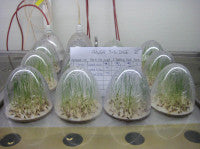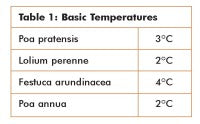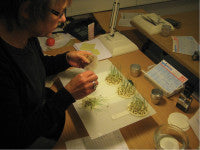Seed germination - one of the most fundamental processes of nature
 "Locked inside every seed is the blueprint to producing a quality turf, but only if given the correct conditions to fulfil that potential"
"Locked inside every seed is the blueprint to producing a quality turf, but only if given the correct conditions to fulfil that potential"
There are no real mysteries about germination, although some would have you believe that all kinds of potions are required for grass seed to germinate. It's a process that's been taking place for millions of years without our intervention. By understanding a seed's basic requirements, we can then utilise or adapt environmental conditions that support germination and seedling development.
Seed Structure and Germination
That dry husky thing, that arrives every year as your seed mixture, holds far more than its appearance would convey. Locked inside every seed is the blueprint to producing a quality turf, but only if given the correct conditions to fulfil that potential. Without the combination of adequate oxygen, temperature and water, the process cannot take place. This may sound fairly obvious, but it is usually one of these key factors that are missing if you're having trouble in getting your seed to germinate
During seed germination the seed has to absorb water, which swells the seed to break the outer husk and trigger the embryo into producing the hormone gibberellin (GA).  This growth regulating hormone activates the aleurone layer which, in turn, secretes amylase for the hydrolysis of starch and proteins into the endosperm. The breakdown of the starchy endosperm then supplies sugars, which are consumed by the emerging radicle extension from the seed and feed early roots and first leaf development.
This growth regulating hormone activates the aleurone layer which, in turn, secretes amylase for the hydrolysis of starch and proteins into the endosperm. The breakdown of the starchy endosperm then supplies sugars, which are consumed by the emerging radicle extension from the seed and feed early roots and first leaf development.
It is at this point, when the seedling has exhausted the food reserves within the seed, that germination ends and establishment starts. This is a critical phase in the life of the grass plant when they are most vulnerable to mechanical damage, water stress and disease. The seed has now done its job and no longer has any influence on further development. It is then external environmental conditions which determine how successful establishment is.
Soil Temperature and Germination
So, with these basic requirements in mind, let's look at some points for consideration for your pending renovation programmes.
No matter the weather conditions, a lot of grass seed is going to be sown out this coming spring but, at this time of year, it makes sense to focus on soil temperature in relation to germination. Obviously, the goal is to achieve the very best results, whether renovating or establishing new sports surfaces.
The first step for the seed in its germination process is the absorption of water. In early spring, there will be plenty of water/moisture available for the seed, but later on, especially if the seed bed preparation is done without regard to the capillary water, water shortage can be fatal. 
Germination is strongly related to soil temperature. The higher the soil temperature is in spring the quicker germination will be. Seeds sown in conditions below the basic (minimum) temperature for germination (this value varies from species to species), will not start their germination processes.
If a seed needs to wait for suitable ground temperatures, there is an increased risk of reduced seed viability through either rotting or the food source within the seed becoming depleted as the seed falls in and out of the germination process.
Danish research has shown that the respective grass species require certain accumulated soil temperatures before they will achieve suitable germination levels. A seeds germination rate can be calculated based on the temperature sum. The temperature sum is defined by the daily temperature the seed is exposed to minus the basic temperature for germination.
 The table shows the basic temperatures that different grass species need in order to initiate the germination process. For example Poa pratensis has a basic temperature of 3OC. Once sown, the soil temperature will begin to influence the seed germination process. Therefore, one day at 10OC will add 7OC to the temperature sum (average temperature minus the basic temperature equals the temperature sum). Furthermore, a weekly average temperature of 11OC will give a temperature sum of 56OC and so on. The temperature sum is a vital component in the prediction of the rate of seed germination.
The table shows the basic temperatures that different grass species need in order to initiate the germination process. For example Poa pratensis has a basic temperature of 3OC. Once sown, the soil temperature will begin to influence the seed germination process. Therefore, one day at 10OC will add 7OC to the temperature sum (average temperature minus the basic temperature equals the temperature sum). Furthermore, a weekly average temperature of 11OC will give a temperature sum of 56OC and so on. The temperature sum is a vital component in the prediction of the rate of seed germination.
Temperature sums can be translated backwards into days. In figure 3, the number of days required for seeds to reach 50% germination can be seen for four different grass species at three different average temperatures.
 As you can see with all four species, increased average temperature improves germination rates dramatically. In reality, average temperatures as low as 5OC are not ideal to kick start the germination process. These values highlight the importance of temperature as a key factor in this complex process.
As you can see with all four species, increased average temperature improves germination rates dramatically. In reality, average temperatures as low as 5OC are not ideal to kick start the germination process. These values highlight the importance of temperature as a key factor in this complex process.
Only a small increase in daily averages results in a large change in the temperature sum which, in turn, leads to a very visible reduction in germination time. Equally, higher soil temperatures will result in faster seedling growth and overall establishment. Lolium perenne is, naturally, a rapid germinator, but unfortunately so is Poa annua!
 Germination test is one of the most important parts of the certification regulations. In the laboratory, Lolium perenne must germinate eighty percent as a minimum, but in lab practice well over ninety is often achieved. The pictures show Lolium perenne seven days after test start, which equals the first counting in Lolium perenne. The shoots are now already approximately seven centimetres high due to optimal conditions (30OC day temperature for 8 hours + light for 8 hours and 20OC night temperature for 16 hours), which cannot be reached in the field, even though it is worth a try. The second count, after fourteen days, will normally only add zero or a few percent to the germination. In the field, we also want fast germination in order to maximise germination rates.
Germination test is one of the most important parts of the certification regulations. In the laboratory, Lolium perenne must germinate eighty percent as a minimum, but in lab practice well over ninety is often achieved. The pictures show Lolium perenne seven days after test start, which equals the first counting in Lolium perenne. The shoots are now already approximately seven centimetres high due to optimal conditions (30OC day temperature for 8 hours + light for 8 hours and 20OC night temperature for 16 hours), which cannot be reached in the field, even though it is worth a try. The second count, after fourteen days, will normally only add zero or a few percent to the germination. In the field, we also want fast germination in order to maximise germination rates.
This, therefore, highlights the significance of the forthcoming months and the weather they may bring. Will there be the prolonged winters of previous years, or will warm south westerly winds bring an early spring?
Predicting the climate we will experience can be left to the weatherman, but judging when best to sow your mixtures lies in your hands in making use of your facilities equipment and local weather conditions. Forcing seed to germinate into conditions which will not sustain good growth thereafter is not good practice!
